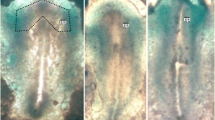Abstract
Proteoglycans from chicken embryos bind neuralizing and vegetalizing inducing factors. The proteoglycan-factor complexes have no inducing activity. Enzymatic cleavage of the core proteins of the proteoglycans abolishes inhibition of the inducing activity by proteoglycans. The possible significance of the formation of complexes of inducing factors with proteoglycans is discussed.
Similar content being viewed by others
References
Andres JL, DeFalcis D, Noda M, Massagué J (1992) Binding of two growth factor families to separate domains of the proteoglycan betaglycan. J Biol Chem 267:5927–5930
Asashima M, Nakano H, Uchiyama H, Sugino H, Nakamura T, Eto Y, Ejima D, Davids M, Plessow S, Chickocka I, Kinoshita K (1991a) Follistatin inhibits the mesoderm-inducing activity of activin A and the vegetalizing factor from chicken embryo. Roux's Arch Dev Biol 200:4–7
Asashima M, Uchiyama H, Nakano H, Eto Y, Ejima D, Sugino H, Davids M, Plessow S, Born J, Hoppe P, Tiedemann H, Tiedemann H (1991b) The vegetalizing factor from chicken embryos: its EDF (activin A)—like activity. Mech Dev 34:135–141
Asashima M. Nakano H, Uchiyama H, Sugino H, Nakamura T, Eto Y, Ejima D, Nishimatsu S, Ueno N; Kinoshita K (1991c) Presence of activin (erythroid differentiation factor) in infertilized eggs and blastulae of Xenopus laevis. Proc Natl Acad Sci USA 88:6511–6514
Born J, Tiedemann H, Tiedemann H (1969) Activation of a morphogenetic factor by electrophoresis. FEBS Lett 2:251–254
Born J, Geithe HP, Tiedemann H, Tiedemann H, Kocher-Becker K (1972a) Isolation of a vegetalizing inducing factor. Hoppe-Seyler's Z Physiol Chem 353:1075–1084
Born J, Tiedemann H, Tiedemann H (1972b) The mechanism of embryonic induction: Isolation of an inhibitor for the vegetalizing factor. Biochim Biophys Acta 279:175–189
Chertov OJ, Krasnosel'skii AL, Bogdanov ME, Hoperskaya OA (1990) Mesoderm inducing factor from bovine amniotic fluid: purification and N-terminal amino acid sequence determination. Biomed Sci 1:499–506
Ericson MC, Elbein AD (1988) Biosynthesis of cell wall polysaccharides and glycoprotein. In: Preiss J (ed) Carbohydrates. (The biochemistry of plants, vol 14) Academic Press, New York
Geithe H-P, Tiedemann H, Tiedemann H (1990) Electrofocusing of the vegetalizing inducing factor. Biochim Biophys Acta 208:157–159
Grunz H, Tacke L (1986) The inducing activity of the presumptive endoderm of Xenopus laevis studied by transfilter experiments. Roux's Arch Dev Biol 195:467–473
Janeczek J, Born J, Hoppe P, Tiedemann H (1992) Partial characterization of neural-inducing factors from Xenopus gastrulae. Roux's Arch Dev Biol 201:30–35
John M, Janeczek J, Born J, Hoppe P, Tiedemann H, Tiedemann H (1983) Neural induction in amphibians. Transmission of a neuralizing factor. Roux's Arch Dev Biol 192:45–47
Lopez-Casillas F, Cheifetz S, Doody J, Andres JL, Lane WS, Massagué J (1991) Structure and expression of the membrane proteoglycan betaglycan, a component of the TGF-β receptor system. Cell 67:785–795
Mangold O (1923) Transplantationsversuche zur Frage der Spezifität und der Bildung der Keimblätter. Roux's Arch Entwicklungsmech Org 100:198–301
Massagué J (1992) Receptors for the TGF-β family. Cell 69:1067–1070
Mikhailov AT, Gergolyuk NA (1987) Biochemistry of embryonic induction: identification and characterization of morphogenetic factors. Sov Sci Rev Physiol Gen Biol 1:267–306
Neufang O, Born J, Tiedemann H, Tiedemann H (1978) A proteoglycan with affinity for the vegetalizing factor. Characterization by density gradient centrifugation. Med Biol 56:361–365
Niebel J, Tiedemann H, Tiedemann H (1973) Studies on an inhibitor of embryonic differentiation. Characterization by isoelectric focusing or filtration on sephadex. Eur J Biochem 32:242–246
Plessow S, Davids M, Born J, Hoppe P, Loppnow-Blinde B, Tiedemann H, Tiedemann H (1990) Isolation of a vegetalizing factor after extraction with acid ethanol. Concentration dependent inducing capacity of the factor. Cell Differ Dev 32:27–38
Saxén L (1961) Transfilter neural induction in amphibian ectoderm. Dev Biol 3:140–152
Saxén L, Toivonoen S (1961) The two gradient hypothesis in embryonic induction. The combined effect of two types of inductors mixed in different ratios. J Embryol Exp Morphol 9:514–533
Segarini PR, Seyedin SM (1988) The high molecular weight receptor to transforming growth factor β contains glycosaminoglycan chains. J Biol Chem 263:8366–8370
Smith JC, Yagoob M, Symes K (1990) Identification of a potent Xenopus mesoderm-inducing factor as a homologue of activin A. Nature 345:729–731
Takata C, Yamada T (1960) Endodermal tissues developed from the isolated newt ectoderm under the influence of guinea pig bone marrow. Embryologia 5:8–20
Tiedemann H (1986) Test of embryonic inducing factors: Advantages and disadvantages of different procedures. In: Serrero G, Hayashi J (eds) Cellular endocrinology. Alan R Liss Inc, New York, pp 25–34
Tiedemann H, Tiedemann H (1959) Versuche zur Gewinnung eines mesodermalen Induktionsstoffes aus Hühnerembryonen. Hoppe Seyler's Z Physiol Chem 314:156–176
Tiedemann H, Tiedemann H (1964) Das Induktionsvermögen gereinigter Induktionsfaktoren im Kombinationsversuch. Rev Suisse Zool 71:117–137
Tiedemann H, Becker U, Tiedemann H (1963) Chromatographic separation of a hindbrain inducing substance into mesodermal and neural-inducing subtractions. Biochim Biophys Acta 74:554–560
Tiedemann H, Lottspeich F, Davids M, Knöchel S, Hoppe P, Tiedemann H (1992) The vegetalizing factor. A member of the evolutionary highly conserved activin family. FEBS Lett 300:123–126
Wang XF, Liu HY, Ng-Eaton E, Downward J, Lodish HF, Weinberg RA (1991) Expression, cloning and characterization of the TGF-β type III receptor. Cell 67:797–805
Yamada T, Takata K (1961) A technique for testing macromolecular samples in solution for morphogenetic effects on the isolated ectoderm of the amphibian gastrula. Dev Biol 3:411–423
Yamaguchi Y, Mann DM, Ruoslahti E (1990) Negative regulation of transforming growth factor β by the proteoglycan decorin. Nature 346:281–284
Author information
Authors and Affiliations
Additional information
Correspondence to: H. Tiedemann
Rights and permissions
About this article
Cite this article
Tiedemann, H., Born, J. & Tiedemann, H. Proteoglycans with affinity for the neuralizing factor and the vegetalizing factor (activin A homologue). Roux's Arch Dev Biol 202, 316–320 (1993). https://doi.org/10.1007/BF00188730
Received:
Accepted:
Issue Date:
DOI: https://doi.org/10.1007/BF00188730




